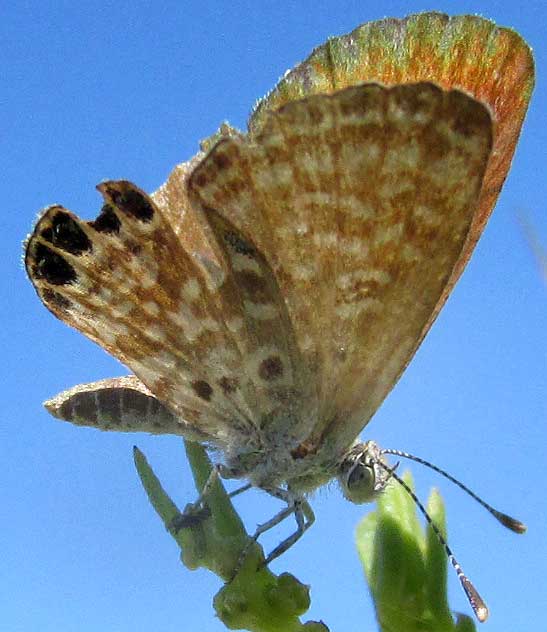Excerpts from Jim Conrad's
Naturalist Newsletter

from the November 2, 2014 Newsletter issued from Río Lagartos, on the Yucatan Peninsula's northern coast (~N21.60°, ~W88.16°), Yucatán state, MÉXICO
WESTERN PYGMY-BLUE BUTTERFLY
Out among the wind-swept dunes where sunlight on the whitish, salt-encrusted soil is blinding, you're likely to spot a butterfly so small that you wonder how it deals with the wind. If you watch it awhile you see that it keeps close to the ground, so that's one way. A picture of this tiny butterfly is shown above.
Though the wings' undersides are mottled and eyed, the wings' open to reveal plain rusty color.
When volunteer identifier Bea in Ontario identified our little butterfly as the Yucatan's own subspecies of the Western Pygmy-blue Butterfly, BREPHIDIUM EXILIS YUCATECA, I was thrilled. One reason was that not only do our dune butterflies constitute a subspecies endemic only to the arid coastal zone of the northern Yucatan Peninsula. Another was because the Western Pygmy-blue species is recognized as one of the smallest butterflies in the whole world, and the very smallest in North America, with a wingspan of only 1/2 - 3/4 inch (1.2 - 2 cm).
The Western Pygmy-blue species with its various subspecies is common and widely distributed from Central California east to southern Nevada, central Arizona, central New Mexico, and western Texas, south through Mexico to Venezuela, plus in the US it migrates to Arkansas, Nebraska, and Oregon. It's just the subspecies yucateca that's endemic here.
Western Pygmy-blue caterpillars feed on members of the Goosefoot Family, the Chenopodiaceae, which in our salty dune area mainly means Saltbush (genus Atriplex), Glasswort (genus Salicornia) and Seepweeds (genus Suaeda).
You can download for free the 1970 journal paper in which the yucateca subspecies of the Western Pygmy-blue butterfly was first described, with interesting notes, at http://images.peabody.yale.edu/lepsoc/jls/1970s/1970/1970-24(1)3-Clench.pdf.